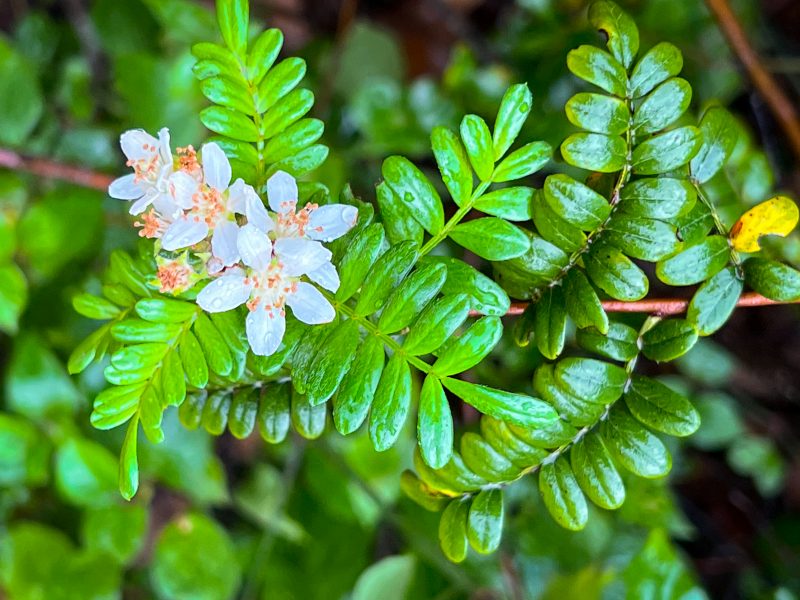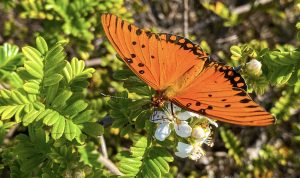Flora of Hawaii: Ulei

ʻUlei is an indigenous plant: It is found on all of the Hawaiian Islands except Niihau and Kahoolawe. It is also found in the Cook Islands, Tonga, Rarotonga, Rapa Iti in the Austral Islands, and a single remaining plant on Pitcairn Island.
Pronunciation: (oolayee) It is very important to pronounce ʻulei correctly emphasizing the ‘i’ at the end, otherwise in Hawaiian it will sound like a particular part of the male anatomy.
Hawaiian Names: uʻulei or on Molokai it is called Eluehe.
Common Names: Hawaiian Hawthorne, Hawaiian Rose
Scientific Name: Osteomeles anthylidifolia
Family name: Rosaceae, the very large Rose family of nearly 3,000 species (roses, strawberries, raspberries). There are three other endemic members: Hawaiian strawberry or ohelo papa (Fragaria chiloensis subsp. sandwicensis), and two species Hawaiian raspberries or akala (Rubus hawaiensis & R. macraei). All have edible fruit, but range from bland to bitter to sweet.
Range: This plant is found in a wide range of habitats from near the ocean on cliffs all the way up through lava fields, the lowland dry to moist forests and mesic forests.
Plant: The plants grow from a sprawling shrub ground cover to an upright shrub-like tree with a spread of 4 to 10 feet, some specimens on Maui and Hawaiʻi are well over twenty feet! The vine-like branches pile up to form a dense tangle along the side of the trail.
Flowers: The showy white flowers look somewhat like a wild rose and grows in small clusters of 3 to 6 blossoms at the ends of the branches. They bloom in winter and spring and are slightly fragrant, reminiscent of rose with a hint of mountain apple.
Fruit & Seeds: The fruits are a similar shape to rose hips and are white to whitish with lavender flush. They contain up to four very hard seeds that are small and yellowish. The fruits are edible but somewhat bland-tasting.
Leaves: The glossy green leaves are odd-pinnately compound, meaning that pairs of small leaflets occur on opposite sides of the leaf stalk, with the one at the tip. The leaves are about 3 inches long and made of up of 15 to 25 small leaflets.
Traditional Uses: The early Hawaiian had a number of uses for ʻulei, including fashioning the very hard reddish brown wood into digging sticks, long spears for catching octopus, kapa beaters, musical instrument, back scratchers, carrying poles for water and food. The white fruit produced a lavender to purple dye for kapa (tapa). The strong flexible branches were looped to make round fish nets. The small sweet fruits were eaten and is similar to the taste of rose petals. ʻulei wood was fashioned into spears for the games of spear throwing and spear fencing. Short tapered sticks were used to play the game of pahee. The flowers and fruit of ʻulei were used in lei making.
Medicinal Uses: Early Hawaiians used the seeds and buds as a laxative for babies. The leaves, root bark and salt were pounded together and the liquid used for deep cuts.
Cultural meaning: To be powerful, a ruler must have the loyalty of the common people, as well as the chiefs. He ʻulei kolo. A creeping ʻulei. An expression applied to a tough, strong person.
Landscaping: This is a hardy xeric plant requiring little or no maintenance once established. This a great addition to any garden from a specimen plant, to a low hedge or a mass planting on a slope, it all looks good. But in many landscapes ʻulei is grown far too wet, which produces luxuriant growth but little or no flowers. Cut back on watering to initiate flowering. Although these plants can be grown in containers, they does best when planted in the ground. Few pests bother this one and its shiny leaves and beautiful flower clusters are awesome features. Once its established in the ground you don’t even have to worry about watering.
ʻUlei is the featured image on the banner of the December 1, 2022 HTMC newsletter.
Information gathered with assistance from John B. Hall.
Please note that unfortunately the diacritical marks in Olelo Hawaiian are not available using this website platform.
Sources:
A Hiker’s Guide to Trailside Plants in Hawaii by John B. Hall, pg. 49
http://nativeplants.hawaii.edu/plant/view/Osteomeles_anthyllidifolia/
https://www2.hawaii.edu/~eherring/hawnprop/ost-anth.htm
http://data.bishopmuseum.org/ethnobotanydb/ethnobotany.php?b=d&ID=ulei

